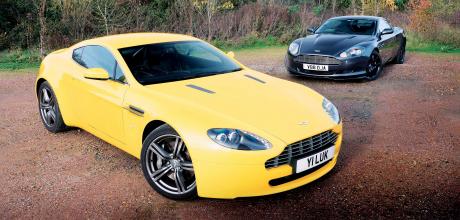2008 Aston Martin V8 Vantage 4.7 Auto vs 2005 Aston Martin DB9 6.0 Auto
Despite the V8 Vantage and DB9 having much in common – including age, performance and current values – with one a pure sports car and the other more of a comfortable GT, they’re also very different. To discover which we prefer, we’re comparing an example of each.
V8 VANTAGE VS DB9 WEAPON OF CHOICE
SAME EXCITEMENT AND NOW THE SAME PRICE
Not only did the V8 Vantage and DB9 arrive at roughly the same time during the mid-2000s, but almost two decades later early examples have similar values. We compare an example of each to decide which you should buy today.

The difficulty in life is the choice,” said the Irish novelist, George A. Moore, once. He had a point. From choosing what flavour of ice cream to buy to which TV channel to watch, from where to go on holiday to whether or not we should put the heating on, we spend much of our lives making decisions.
If you have between £25k to £45k to spend on an Aston Martin, then you have one more to make, since the first generation of V8 Vantage and DB9 are now worth roughly the same price. Although one is a V8-engined sports car and the other more of a V12 grand tourer, they’re both good-looking, fast and highly desirable machines, making choosing between them more difficult than between Rocky Road and Mint Choc Chip.
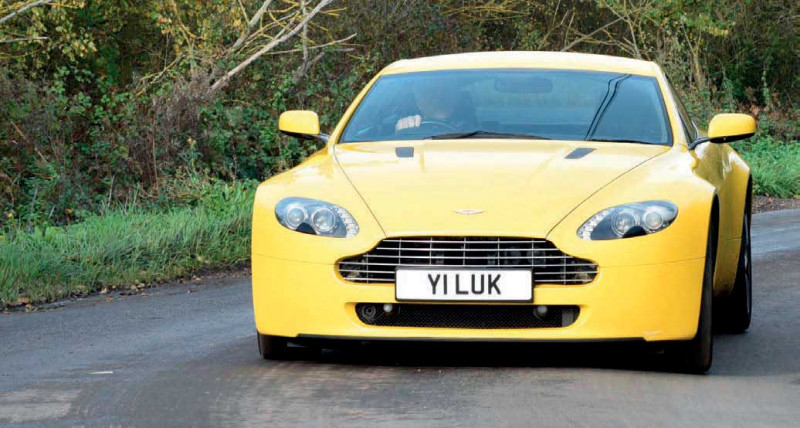

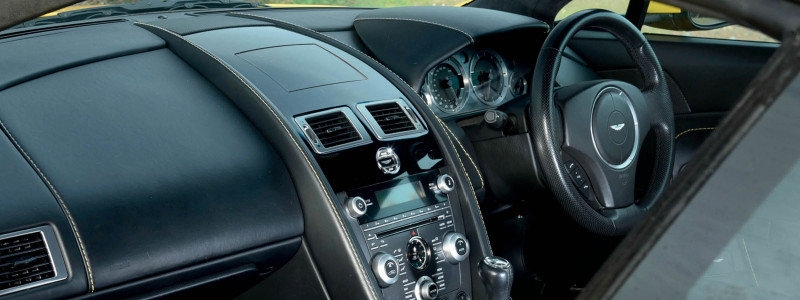

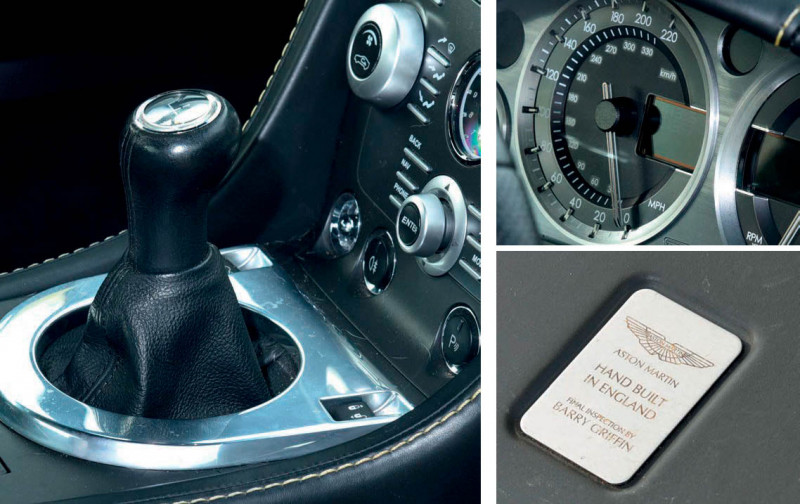
The DB9 made its debut first at the 2003 Frankfurt Motor Show. A brand-new design, it was initially started by designer director, Ian Callum, but when the Scot left for the same position at Jaguar in 1999, it was finished by his replacement, the former BMW designer from Denmark, Henrik Fisker. An effortlessly elegant and graceful car, in one sweep it made the well-matured beauty it replaced, the decade-old DB7, look old-fashioned and awkward. Yet by not reinventing the wheel, the car’s pedigree was clear for even the most passing of observers.
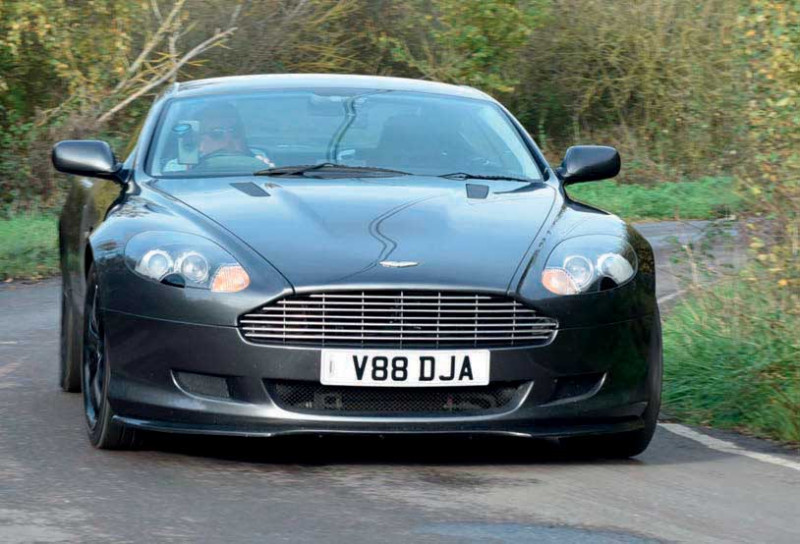

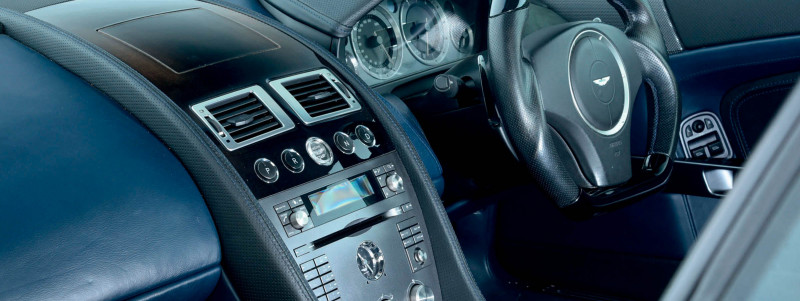
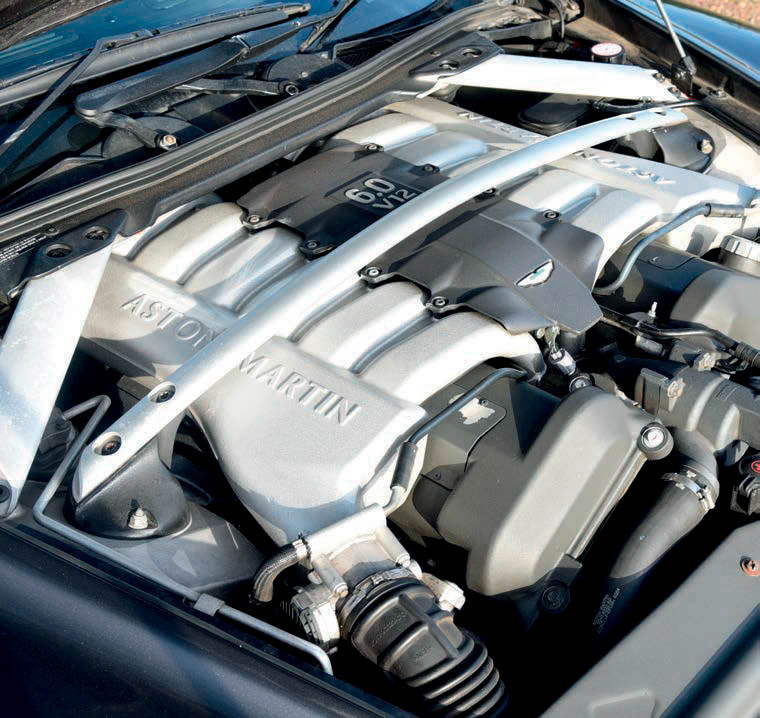
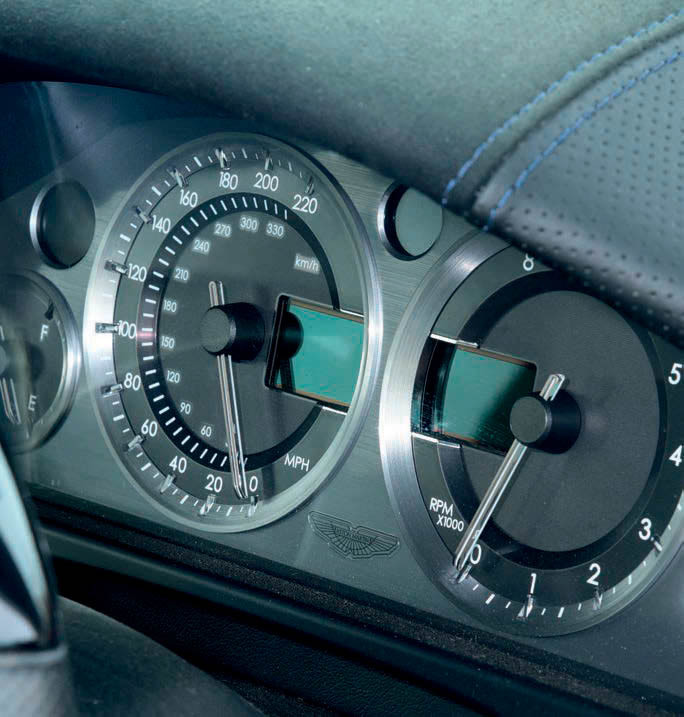
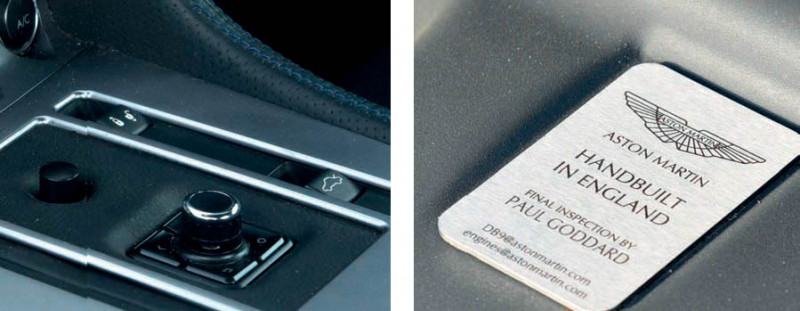
“It’s achingly beautiful,” said Road & Track magazine in 2004 about the car. “Aston found no reason to start a styling revolution. The DB9, like the Vanquish, DB7, and V8 Vantage, relies on classic proportions, long-established Aston styling cues, big 19in wheels, and simple sculptured forms to achieve its gorgeous looks.”
Although as mentioned earlier it replaced the DB7, the new car wasn’t called the DB8 as expected since Aston Martin was worried customers would incorrectly assume it was V8-powered as under the bonnet was roughly the same 6.0-litre V12 as the outgoing DB7 Vantage. But with carbon fibre driveshafts, new cams, inlet and exhaust manifolds as well as a revised engine management and lubrication system, its maximum power had been increased from 420bhp to 450bhp, resulting in the DB9 having an incredible 180mph top speed. The car was only initially available with a six-speed automatic by ZF but a manual gearbox by Italian transmission specialist, Graziano, later became an option.
At 4,720mm long and 2,016mm wide the DB9 was might have been bigger than the DB7, but with its frame and several panels constructed from aluminium (the front wings and bootlid were composite), it weighed 1,760kg, 65kg less than its predecessor. Not only did this increase performance, economy and durability but Aston Martin also claimed it was 25 percent lighter than the steel bodyshell of its predecessor.
The result was a devastatingly fast machine that rivalled whatever was coming out of Maranello or Sant’Agata. “There are more powerful units and faster-changing gearboxes, but nothing matches the DB9’s desirability, sense of occasion and sheer usability,” was Autocar magazine’s assessment in its 1 June 2004 issue.
The DB9 was the first Aston to have been based on the company’s then-new VH (vertical horizontal) platform that would be the basis for all future models, although some elements of its design also sounds spectacular: throbbing menacingly at idle, then puffing out its chest with a stentorian roar” were first seen on the chassis used by the first Vanquish from 2001.
The DB9 was also the first Aston to be produced at the company’s then-new manufacturing facility outside Gaydon in Warwickshire, meaning it was the first to be partly produced by automated production. Although this no doubt caused the purists to spill their tea, Aston insisted that due to everything being made or assembled on site, there was a greater hand-built content than the DB7 or Vanquish, while the robot section of the production guaranteed greater precision and quality.
The larger factory, improved assembly techniques and, more importantly, the flexible VH platform allowed Aston Martin to increase production. During an interview in the October 2003 issue of Top Gear magazine, the company’s then CEO, Dr Ulrich Bez, said it could potentially rise to 4,500-5,000 units per year. Although still a tiny fraction of what Porsche produced, it was a huge improvement over the previous tiny figure of 1,470 in 2001.
And sure enough, less than two years later a second Aston Martin to use the VH platform arrived. Although heavily based on the AMV8 Vantage concept that was revealed at the Detroit Auto Show in January 2003, the eventual production version didn’t debut until the 2005 Geneva Motor Show.
The family resemblance might have been clear but by being smaller, lighter and much more muscular in appearance, if the DB9 was a yacht then this was a nimble speed boat.
“The differences are subtle but they are also compelling,” said Top Gear in its April 2005 issue. “The V8 is very clearly the DB9’s punk little brother. It’s shorter in the snout, wider around the wheels and more predatory in profile.”
As with the DB9, the chassis and panels were all aluminium resulting in it weighing a minuscule 2,570kg. Plus, it was powered by a new-to-Aston 4.3-litre engine which, although related to Jaguar’s 4.2-litre AJ unit, was repackaged with a dry sump. The 32-valve cylinder head architecture was slightly primitive, the inlet-only variable valve timing unique to Aston. The engine produced 380bhp and through a six-speed Graziano manual gearbox the car could reach 60mph in as little as 4.8 seconds and had a top speed of 175mph. “The raw, unabashed shrieking fury that emerges from the tail pipes above 4,500rpm is just about consolidated by the accelerative force,” said Autocar in its November 22 2005 issue.
The result was a very different car with a very different character that had a very different price tag than its bigger sibling. At £80k in 2005 it was over 20 grand less than the DB9, making the V8 Vantage something not often attributed to Aston Martin, affordability.
This together with its good looks and high performance made the car relatively popular and between 2005 and 2017, when it was replaced by the second and current generation of Vantage, 21,648 of the first were built. There were also another 3,052 V12 models that had the same 6.0-litre engine as the DBS, which arrived in 2009.
And although it was larger and more expensive, the DB9 was almost as popular with a little over 16,500 produced until the car was superseded by the DB11 in 2016. Admittedly, these are tiny numbers compared to the amount of 911s that Porsche churns out on an annual basis, but it makes them two of Aston’s most popular and successful models.
These relatively high numbers have had a significant effect on their used values since early examples of both now start at around £25,000. Similar to choosing between two weeks in Kos or Corfu, this results in a tempting if confusing choice. What’s the better decision; a V8 sports car or a V12 coupe? There’s only one way to find out.
The two examples shown here perfectly illustrate the differences between the two models. While the Meteorite Grey DB9 is every inch the discreet, subtle and elegant gentleman’s carriage that post-war Astons have always been, the Speed Yellow Vantage couldn’t be more in your face than if it had just drunk several cans of Stella. Personally, I like it, the colour matching the car’s larger-than-life character and showed a new way of thinking for Aston, but I understand why it might not be to the tastes of traditionalists.
Although excited to try both, it’s the DB9 I head to first. Even to get close to this beautiful car, to soak in its voluptuous curves and impressive size, is as much a thrill for me now as when I first saw a V8 saloon in the Eighties. By being 338mm longer, it’s much more elegant than the short, stocky and muscular Vantage alongside. And unlike most of us, it hasn’t aged; while I’m no longer the fresh-faced youth I was in 2003, the DB9 arguably remains as contemporary and fashionable as when it made its debut two decades ago. It’s worth pointing out that this particular car has an aftermarket carbon fibre front valance fitted and its 19in, ten-spoke alloys have been repainted black.
If I’m honest, I was expecting a slightly better quality of interior than what faces me. Admittedly in terms of materials used and the overall build quality, it’s a huge improvement over the DB7’s cheap feeling, overly archaic Ford parts bin special, but the grey plastic fascia and switchgear which was swiped from Aston’s sister company at the time, Volvo, lacks the panache you’d expect for a car that in 2005 cost more than most people’s homes. I like the dials in the binnacle, though, their polished silver finish having an almost jewelled effect.
All is forgiven when I turn the ignition key, press the starter button in the centre of the console and hear the 6.0-litre V12 burst into life with a smooth, refined but still noticeable roar. Whether it’s a piece of Italian exotica or an arguably humbler Jaguar XJ12, there’s something special about a V12-engined car and this 2005 Aston is no different.
There’s no traditional gearlever; the six-speed automatic transmission is instead controlled by four discreet buttons located just above the radio. Needing the same amount of effort to operate as using a TV remote, I press D for drive, grab the chunky flat-bottomed steering wheel, squeeze the throttle and slowly make a start.
The 6.0 V12 is smooth and quiet on the move, only the rev-counter needle telling me the engine is doing anything. With the supple suspension effortlessly absorbing the worst that the British roads can throw at me, the cabin remains calmer than an exclusive gentleman’s club at midnight.
After pressing the D button on the dash, thanks to its seamless changes, I haven’t given the transmission a second’s thought and it’s easy to understand why a mere 385 DB9 coupes and 237 Volantes were sold with the manual ‘box.
But when the road clears and I give the throttle the beans the car is immediately transformed. As soon as the gearbox kicks down, it’s changed from the soft and gentle grand tourer it has so far been into something much harder. The free- revving V12 is quick to respond, offering an instant surge of smooth yet formidable performance. With so much power, it continues to accelerate with a hardness that takes me by surprise and although I have no doubt it will continue to do so until it hits 186mph, with a corner fast approaching, I back off.
Admittedly this is a miserable autumnal day, the roads slipperier than if they’d been covered in cooking oil, but always aware of the DB9’s considerable size and firepower under the bonnet, I don’t feel comfortable attacking corners with speed especially since the suspension is clearly tuned for comfort rather than performance driving. For that kind of tomfoolery, Aston Martin developed the DBS in 2008 that was lighter, faster and much more driver-focused.
That leaves the DB9 as more of a traditional, old-fashioned grand tourer, the sort that’s still perfect for cruising down the long French autoroutes to your summer residence on the Côte d’Azur, the comfortable ride but still powerful engine making short work of the 1,000-mile journey.
The Vantage seen here has a 4.7-litre version of the V8 that was introduced in 2008 to answer criticisms that the original 4.3 wasn’t powerful enough. The extra 455cc pushed the power to 420bhp (an increase of 11 percent), torque to 347lb ft (up 15 percent) and lowered the 0-60mph by 0.2 of a second to 4.7 seconds, making it identical to the DB9’s.
The chassis was tweaked at the same time, with the coupe inheriting the improved components and stiffer spring rates already fitted to the roadster, which had arrived in 2006, while Bilstein dampers were now standard. The interior also received the same fascia as the DB9 and DBS.
“Aston’s revisions for the Vantage are far from glaring,” said Autocar in its 21 May 2008 issue, “it takes time and a decent drive to fully reveal them – but invest in this and you’ll find a car that preserves the character of the original but adds polish where it was needed.”
In terms of layout, the same Volvo-sourced switchgear and the materials used, the interior looks and feels similar to the DB9’s which was perhaps more acceptable for a car that cost £83,000. Yet I reckon the Jaguar XKR’s cabin from the same era feels similar in quality, yet in 2008 was over ten grand less than this car but offered similar levels of performance.
When I look behind me I see the biggest difference between the Vantage and DB9’s interior – seats. Whereas the larger car was marketed as a 2+2 (although in reality, the rears are barely large enough for anyone), the Vantage is strictly for two people only.
The car’s more purposeful image is confirmed when the V8 fires and it sounds louder and more aggressive than the DB9’s V12. This example has the Graziano six-speed manual although the Vantage was also available with a six-speed automatic. After embarrassingly discovering more than once that the clutch has a high biting point, making it easy to stall, it’s soon obvious this is a very different animal to the DB9.
The acceleration times of the two cars might be officially identical at 4.7 seconds, but from the driving seat, the Vantage’s has a rawer, harder, more ballistic edge. Give the throttle a proper shove and it releases its energy faster than the DB9, shoving me backwards like the lager-swilling lout it clearly is.
The subsequent deep and melodic growl from the engine under full power fills the cabin in the same way Luciano Pavarotti’s voice used to in the Royal Albert Hall, until it reaches a screaming crescendo and I finally reach down, grab the stubby gearlever and change up. With short, sharp and precise shifts, the Graziano transmission is a perfect match for the engine, allowing for easy access to all that torque and power.
Lighter, more agile and with much tauter suspension than the DB9’s, I’ve only been in the Vantage for 30 seconds and I’m already comfortable enough to push it harder through corners. With beautifully weighted steering, 50/50 weight distribution and limited body roll, the yellow coupe remains better composed no matter how hard I push through corners, the Bridgestones fitted to the 19in alloys thankfully finding enough grip in the slippery conditions to keep me out of trouble and the car out of a ditch.
As I reluctantly hand the car back to its owner, two things occur to me. Firstly, even after this brief drive, it’s easy to understand why the car was popular when new and why it remains so today. Secondly, the Vantage is clearly as different from the DB9 as luxury ice cream is from low fat yoghurt. So which one of these magnificent yet affordable cars do I choose?
Many years ago and following another two-car test, I was criticised by a reader for not putting a car first and, like a modern school sports day, both were winners. I promise you, that won’t happen here, but I have to admit these are equally remarkable cars, the DB9 especially. In this age of greener, smaller, and less imposing cars, it was fabulous to drive one with a V12, especially when it’s as goodlooking as this.
Compared to the ordinary cars around me, the big grey Aston must have looked like a UFO, meaning few would be able to guess this astonishing car costs less than a family hatchback.
Yet the truth is it’s too big, too cumbersome and too extravagant for my tastes. Admittedly I was driving the car on wet and narrow roads rather than in its natural habitat, those empty French autoroutes, but I never felt totally at ease behind the wheel.
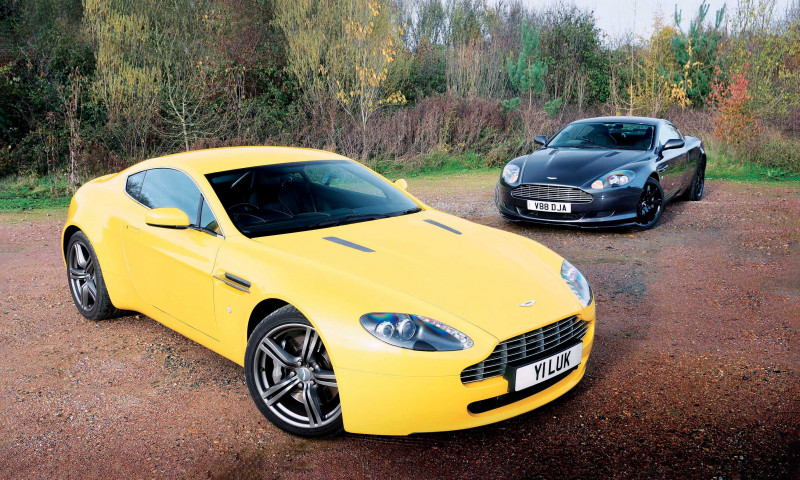
By comparison, other than the tricky clutch, I immediately felt at home in the Vantage, finding its instant power delivery, direct steering and sharp transmission more enjoyable than the DB9’s. It’s an oldschool, V8-engined, two-seater sports car, of the sort that this country was once famous for and which I personally find more desirable than V12 GTs, especially when they’re the same price. We might have to make endless decisions every day but this is one I’m all too happy to make.

Thanks to: Luke and Dennis Harding for supplying their V8 Vantage (luden.co.uk) plus DB9 owner, David Ashford
TECHNICAL DATA 2008 Aston Martin V8 Vantage 4.7 Auto
- Engine: 4,735cc V8
- Max Power: 420bhp
- Max Torque: 347lb ft
- Max speed: 180mph
- 0-60mph: 4.7secs
- Transmission: 6-spd auto
- Weight: 1,610kg
- Price new: £83,000
- Value now 2023: £37,500-£45,000
TECHNICAL DATA 2005 Aston Martin DB9 6.0 Auto
- Engine: 5,935cc V12
- Max Power: 450bhp
- Max Torque: 420lb ft
- Max speed: 186mph
- 0-60mph: 4.7secs
- Transmission: 6-spd auto
- Weight: 1,760kg
- Price new: £103,000
- Value now 2023: £25,000-£45,000


